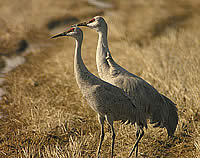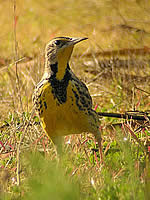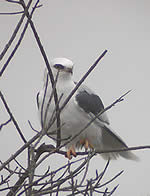





SANDHILL CRANES

SANDHILL CRANES
 "Morning we were awakened by the loud cries of the sandhill crane, performing evolutions in the air, high over their feeding grounds...the crane is a social bird, sometimes assembling together in considerable flocks. They were now in great numbers, soaring aloft in the air, flying with an irregular kind of gyratory motion, each individual describing a large circle in the air independently of his associates, and uttering loud, dissonant, and repeated cries. They sometimes continue thus to wing their flight upwards, gradually receding from the earth, until they become mere specks upon the sight, and finally altogether disappear, leaving only the discordant music of their concert to fall faintly upon the ear."
"Morning we were awakened by the loud cries of the sandhill crane, performing evolutions in the air, high over their feeding grounds...the crane is a social bird, sometimes assembling together in considerable flocks. They were now in great numbers, soaring aloft in the air, flying with an irregular kind of gyratory motion, each individual describing a large circle in the air independently of his associates, and uttering loud, dissonant, and repeated cries. They sometimes continue thus to wing their flight upwards, gradually receding from the earth, until they become mere specks upon the sight, and finally altogether disappear, leaving only the discordant music of their concert to fall faintly upon the ear."
--April 13, 1820, Thomas Say on the Long Expedition to the Rockies
"Our ability to perceive quality in nature begins, as in art, with the pretty. It expands, through successive stages of the beautiful to values as yet uncaptured by language. The quality of cranes lies, I think, in this higher gamut, as yet beyond the reach of words....Our appreciation of the crane grows with the slow unraveling of earthly history. His tribe, we now know, stems out of the remote Eocene. The other members of the fauna in which he originated are long since entombed within the hills. When we hear his call we hear no mere bird. We hear the trumpet in the orchestra of evolution....And so they live and have their being--these cranes--not in the constricted present but in the wider reaches of evolutionary time. Their annual return is the ticking of the geologic clock. Upon the place of their return they confer a peculiar distinction. Amid the endless mediocrity of the commonplace, a crane marsh holds a paleontological patent of nobility, won in the march of aeons...."
--Aldo Leopold, SAND COUNTY ALMANAC, 1949
"Cranes are the stuff of magic, whose voices penetrate the atmosphere of the world's wilderness areas, from arctic tundra to the South African veld, and whose footprints have been left on the wetlands of the world for the past sixty million years or more. They have served as models for human tribal dance in places as remote as the Aegean, Australia, and Siberia."
--Paul Johnsgard, CRANE MUSIC, 1991
A Day with the Cranes
My wife and I are driving along a two-lane road across one of the flatest parts of California. Our dog Bridget looks out the back window. Our first glimpse of the slender gray Sandhill Cranes always comes as we speed east on two-lane Highway 12 from Rio Vista toward the California Central valley. This road is bordered by low fields. Levees rise above even the raised roadbed at the back of a seeming endless expanse of plowed mud, with numerous puddles, sometimes shallow lakes. Man-made levees to keep this farmland from returning to tidal marsh as it was for millenia. Here water wants to dominate. After winter's rain the whole Delta contains more water than dirt. It costs too much to pump out the water which sits until dry months and evaporation. One flooded field swarms with elegant Tundra Swans. Another has Canvasbacks and Coots. White Egrets and Blue Herons are pale, feathered statues in black mud fields. There are few places to pull safely off Highway 12, and the rural traffic on this line-straight road is in a hurry. No towns, no malls, no billboards. If you're not concerned with the abundant birdlife around you, this is just flat countryside to cross quickly.
The cranes are usually far back from the highway and its noise. Best viewing is done from inside the car as the cranes are less likely to worry about a object shorter than they are. Humans viewed against the flat horizon cause cranes to shuffle even further back from the road. The family groups are obvious. The larger male, the female, the more slender young crane without a red facial hood. They may dance a worried pirouette if they encounter another group too closely. They're gregarious but not good at sharing a small space. Even in this flat, open area, distance is measured out in dancing steps. Breeding age Sandhill Cranes have the reddish forehead and white cheeks of their species while the young are generally uniformly sandhill gray. A soft, bustle of feathers droops off the back of the folded wings, forming a cascading tail. And as wondrous as they are to behold, it's most captibvating when a line of slender gray cranes fly past, their calls sounding across the miles and the eons. The sound is somewhere between a rattle and the oldest bassoon being blown with force. Even the scientific "Birds of North America" series is frustrated: "Calls described as trumpeting, bugling, rattling or croaking, but these adjectives do not fully convey the volume or quality of the sound produced by a mature Sandhill Crane."
One scientific fact about the crane's voice is easily grasped. The Sandhill voice benefits from a genus-wide trait of the Grus: elongated trachea that loop inside their chests. This gives them a much longer set of tubing through which to pass air and sound. The same principle later used by humans in making trumpets, trombones and tubas--loops of tubing to enhance the sound. The cranes did it first.
 After we enter short, deadend Woodbridge Road, cranes maintain their distance. Most are a hundred yards or more from the road. Here most vehicles contain people with binoculars, specifically come to see the cranes and swans. If you step from your car, the nearest cranes will amble further back from the road. Only a few farms and a handful of homes are along Woodbridge. Not far west of I-5 is the Phil & Marilyn Isenberg Sandhill Crane Reserve. It has a small gravel parking area and a dirt mound about six feet above the surrounding landscape, giving birders a good vantage point. From here we scan the marsh and muddy fields. Beechey's ground squirrels run about on the dry edges of a drainage ditch. Occasionally they stand on hind legs, peering over weeds at us and our dog, Bridget. They're keenly alert to the female Northern Harrier gliding soundlessly just above the weed tops along the edge of the marsh. When she turns toward our parking lot, squirrels melt into their burrows. The ducks include Pintails, Shoveler, Green-winged Teal, Gadwalls, Canvasbacks. Coots by the hundreds. A few Black-necked Stilts. Tundra Swans, the young still smaller than the adults and colored a sooty gray. In dryer fields across the road are Killdeer, Western Meadowlarks in nervous running flocks, American Pipit along the roadside and anywhere there is barren rocky ground. Black Phoebe work the muddy ditches. We drive on, passing Mockingbirds, Loggerhead Shrike, numerous little American Kestrel on the wires, several perched Red-tailed Hawks, one soaring Turkey Vulture. At a gravel parking lot near a grain elevator: a flock of Savannah Sparrows accompany the meadowlarks in the short grass. This little sparrow shows a glint of sunshine in its cheeks. Meanwhile the meadowlarks have freshly plumaged chests of a bolder buttery yellow. In some fields they sing in the unsually warm winter sun. It's this meadowlark's bright flutey song that informed the aged John Audubon that he'd found a new species when he first heard their song 160 years ago on the American prairie. Earlier explorers had seen the birds, assuming them to be Eastern Meadowlarks.
After we enter short, deadend Woodbridge Road, cranes maintain their distance. Most are a hundred yards or more from the road. Here most vehicles contain people with binoculars, specifically come to see the cranes and swans. If you step from your car, the nearest cranes will amble further back from the road. Only a few farms and a handful of homes are along Woodbridge. Not far west of I-5 is the Phil & Marilyn Isenberg Sandhill Crane Reserve. It has a small gravel parking area and a dirt mound about six feet above the surrounding landscape, giving birders a good vantage point. From here we scan the marsh and muddy fields. Beechey's ground squirrels run about on the dry edges of a drainage ditch. Occasionally they stand on hind legs, peering over weeds at us and our dog, Bridget. They're keenly alert to the female Northern Harrier gliding soundlessly just above the weed tops along the edge of the marsh. When she turns toward our parking lot, squirrels melt into their burrows. The ducks include Pintails, Shoveler, Green-winged Teal, Gadwalls, Canvasbacks. Coots by the hundreds. A few Black-necked Stilts. Tundra Swans, the young still smaller than the adults and colored a sooty gray. In dryer fields across the road are Killdeer, Western Meadowlarks in nervous running flocks, American Pipit along the roadside and anywhere there is barren rocky ground. Black Phoebe work the muddy ditches. We drive on, passing Mockingbirds, Loggerhead Shrike, numerous little American Kestrel on the wires, several perched Red-tailed Hawks, one soaring Turkey Vulture. At a gravel parking lot near a grain elevator: a flock of Savannah Sparrows accompany the meadowlarks in the short grass. This little sparrow shows a glint of sunshine in its cheeks. Meanwhile the meadowlarks have freshly plumaged chests of a bolder buttery yellow. In some fields they sing in the unsually warm winter sun. It's this meadowlark's bright flutey song that informed the aged John Audubon that he'd found a new species when he first heard their song 160 years ago on the American prairie. Earlier explorers had seen the birds, assuming them to be Eastern Meadowlarks.
 Along Woodbridge Road each change in habitat brings different birds. Recently planted vineyards look sterile at first but they're alive with Yellow-rumped Warblers. Kingfishers lurk on the edge of water-filled ditches. One pond has Canada Geese and a pair of sleeping Wood Duck. One field that is only slightly dryer than a lake: Wilson's Snipe and Ring-billed Gulls. A barely dryer field where the puddles are mostly pizza-sized: Dunlin, Black-bellied Plover, Western Sandpipers, a wave of pipits washes over the plowed furrows, California Gulls, Snowy and Great Egret, Blue Heron. A skein of Snowy Geese fly over, black on their flapping wings a key to knowing these are not distant swans who show only white in the air. Then a dark line of large birds sweeps toward us: Canada Geese who let themselves gently down into a grassy field. One farmyard full of small trees has Juncos and Robins.
Along Woodbridge Road each change in habitat brings different birds. Recently planted vineyards look sterile at first but they're alive with Yellow-rumped Warblers. Kingfishers lurk on the edge of water-filled ditches. One pond has Canada Geese and a pair of sleeping Wood Duck. One field that is only slightly dryer than a lake: Wilson's Snipe and Ring-billed Gulls. A barely dryer field where the puddles are mostly pizza-sized: Dunlin, Black-bellied Plover, Western Sandpipers, a wave of pipits washes over the plowed furrows, California Gulls, Snowy and Great Egret, Blue Heron. A skein of Snowy Geese fly over, black on their flapping wings a key to knowing these are not distant swans who show only white in the air. Then a dark line of large birds sweeps toward us: Canada Geese who let themselves gently down into a grassy field. One farmyard full of small trees has Juncos and Robins.
Along Glassock Road a berry tangle has Spotted Towhee, House Finch, Golden-crowned Sparrows. A budding birch tree is full of feeding American Goldfinch. Killdeer squawk and race about on the grass at a small county park. A Scrub-jay watches for anything edible in thge parking lot. Every barnyard in the area has a swirling cloud of various blackbirds and Starlings.
Later we drive Staten Island Road: here a pair of White-tailed Kite hunt from a power line, more Kestrel, Canvasbacks and Ruddy Ducks in flooded fields. Coots galore. Another couple thousand Sandhill Cranes, still feeding as sunset nears. Little clouds of Golden-crowned and White-crowned Sparrows on the weedy road edges.
At the end of the day it's the multitude of crane images that fills your mind, smooths out the wrinkles, demands appreciation. Most often you see a unit of three cranes--the mated pair and last summer's youngster. The family units stay together during the southward migration, the winter in California and the flight back to the traditional breeding grounds that may be as far away as northern Alaska. When resting cranes may lie down with their long spindly legs tucked beneath them. Many families are busily digging in the earth with they six-inch dagger-sharp beaks. They'll devour everything from tubers and seeds to small vertebrates. In several folklore tales around the world the crane is credited with protecting local tribes and farms from snakes. In flight their wings are at the fulcrum with the slender neck pointing forward, legs dangling behind. In one dense flock of cranes we spot a brightly dyed youngster. A rare but regular occurence. This one is cinnamon from head to vent. Often adults only have the rufous staining on their wing or chest feathers. This is self-administered cosmetic coloring, using mud or soil.
There are fewer Sandhill Cranes in California than the number of people passing through Los Angeles International Airport any day of the week. Sadly, Sandhill Cranes are legally hunted in Alaska, Arizona, Colorado, Idaho, Kansas, Montana, New Mexico, North Dakota, Oklahoma, South Dakota, Texas, Utah, and Wyoming. Additionally, Sandhill Crane are hunted in two canadian provinces. Also in Russia. To see the largest crane gathering in the world you must go to the Platte River in Nebraska in March.
http://www.ngpc.state.ne.us/wildlife/guides/migration/sandhill.asp
A day spent with Sandhill Cranes shows how small your world is compared to sweep of time and distance in which these birds live. Among the thousands of cranes in California's Central Valley from November to March are many from Alaska. Some Sandhills migrate annually from Siberia to Mexico and back. Before man walked this continent Sandhills came to California each winter. Ice ages have come and gone. Giant sloth and saber-toothed tiger have disappeared. Crater Lake was formed. The Cranes continued their annual migrations. The Central Valley passed from grassland and marsh to wheat field to irrigated agriculture. The cranes continued, adapted, persevered.
Exposure to the crane may make you impatient with the shallowness and material overload of American culture. There's no need for a sign, "Please turn off your cell phone." Nobody needs a box of popcorn or flat screen TV to enjoy the action. You may be humbled by the crane families feeding and dancing together. The ancient trumpeting calls pre-date human speech and music. Sandhills watching you watch them--a measure of your transience in their ancient struggle to live on this planet.
2006
------------------
Directions
Directions from Orinda to Woodbridge Road
------------------
Crane Links
A page of links to general and regional information about Cranes.
------------------
Full checklist for the day in San Joaquin County, California
Location: Woodbridge Sandhill Crane Area
Observation date: 12/30/06
Notes: Trip included Glasscock Road to the south, Staten Island Road to the north as well as the full length of Woodbridge Road.
Number of species: 61
Snow Goose 30
Canada Goose 80
Tundra Swan 240
Wood Duck 2
Gadwall 10
American Wigeon 40
Mallard 15
Northern Shoveler 320
Northern Pintail 230
Green-winged Teal 60
Canvasback 450
Ruddy Duck 34
Ring-necked Pheasant 1
Pied-billed Grebe 2
Double-crested Cormorant 2
Great Blue Heron 12
Great Egret 30
Snowy Egret 4
Turkey Vulture 1
White-tailed Kite 2
Northern Harrier 3
Red-shouldered Hawk 2
Red-tailed Hawk 7
American Kestrel 15
American Coot 600
Sandhill Crane 5000
Black-bellied Plover 75
Killdeer 300
Black-necked Stilt 40
Greater Yellowlegs 2
Western Sandpiper 500
Dunlin 24
Wilson's Snipe 6
Mew Gull 2
Ring-billed Gull 60
California Gull 20
Mourning Dove 2
Belted Kingfisher 5
Northern Flicker 2
Black Phoebe 14
Loggerhead Shrike 3
Western Scrub-Jay 4
American Crow 50
Ruby-crowned Kinglet 10
American Robin 56
Northern Mockingbird 8
European Starling 120
American Pipit 50
Yellow-rumped Warbler 65
Spotted Towhee 1
Savannah Sparrow 15
Fox Sparrow 2
White-crowned Sparrow 130
Golden-crowned Sparrow 24
Dark-eyed Junco 5
Red-winged Blackbird 65
Western Meadowlark 550
Brewer's Blackbird 1000
House Finch 150
American Goldfinch 30
House Sparrow 60
(See also January in the Delta: Swans, Cranes, Life and Death.)
TOWHEE.NET: Harry Fuller, 820 NW 19th Street, McMinnville, OR 97128
website@towhee.net